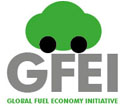
Industry self-reporting:
Working in conjunction with consumer awareness campaigns, it is important for the auto industry to voluntarily release fuel economy data to the public. This ensures consumers are well informed about the product they wish to purchase, and such information can be found on on-line databases, consumer awareness websites, or on labels in car showrooms. This information is also useful in helping governments to calculate corporate average fuel economy for new vehicles on a yearly basis. Below are two examples of industry self-reporting.
India
Indian fuel economy data as measured on the official test was kept confidential until April 2009, but was released by the manufacturers in May 2009 through a read-only file on the website of the Society of Indian Auto-Manufacturers (SIAM). Vehicle attribute data were obtained from manufacturer websites.
U.S.
Fuel economy data is well known and communicated in the U.S. Besides the USEPA website fueleconomy.gov, very specific data on vehicle type, weight, transmission type, etc. are available from publications such as Ward’s Auto Reports and Automotive News. Wards’ Auto Reports now publishes their report jointly with the Alliance of Automobile Manufacturers. The US EPA also publishes the Fuel Economy Trends Report which has been published for a number of years and is published annually. This document follows the trends in fuel economy over the past year and does a number of analyses based on the fuel economy data.







